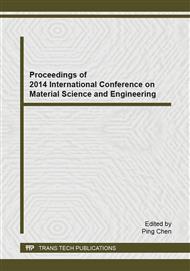p.385
p.392
p.396
p.401
p.408
p.413
p.417
p.422
p.426
Simulation on Electrical Conductivity of CNTs/PE Composites
Abstract:
In order to investigate the electrical conductivity of carbon nanotubes (CNTs)/polyethylene (PE) composites, the relationship curves between the external electrical filed strength and the electrical conductivity of CNTs/PE composites with different microstructures were generated based on numerical simulation. The simulation models of CNTs/PE composites were designed through changing the content, aspect ratio and orientation degree of CNTs. After DC electrical field is applied between top and bottom surfaces of the composites, the distribution of electrical current density was calculated based on the finite element method by using the COMSOL simulating software, and then the electrical conductivity is obtained. Research results indicated the electrical conductivity of the composites increases significantly with the increase of aspect ratio of CNTs at the same CNT content and electrical field strength. As the orientation degree of CNTs along the applied electrical field increases, the electrical conductivity of the composites obviously increases. It can therefore be concluded that the changing of microstructures of CNTs/PE composites is effective to control the electrical conductivity of the composites.
Info:
Periodical:
Pages:
408-412
Citation:
Online since:
October 2014
Authors:
Keywords:
Price:
Сopyright:
© 2014 Trans Tech Publications Ltd. All Rights Reserved
Share:
Citation:


